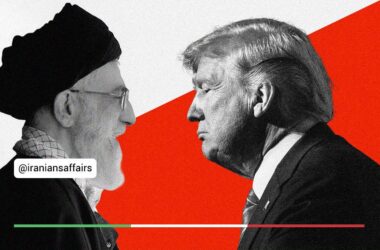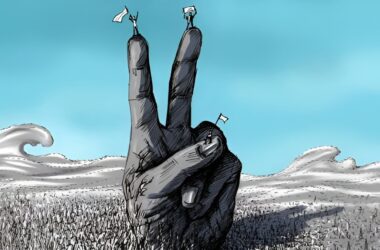Media, as one of the primary tools for social and political change, plays an irreplaceable role in revolutionary processes. On a nation’s journey toward freedom and democracy, national media and revolutionary leadership form two fundamental pillars. In synergy, they contribute to achieving national goals and shaping a brighter future. This article explores the significance of national media alongside revolutionary leadership in Iran and examines the necessity of these two elements.
1. National Media: A Tool for Strengthening Collective Awareness
A national media platform, like Manoto in times of crisis, holds a vital mission: disseminating accurate information and fostering national unity. During protests and revolutions, people need reliable and impartial information. National media can provide precise and transparent reporting to counter the spread of misinformation and rumors often propagated by state-controlled or hostile foreign media.
Key imperatives for national media include:
- Clarifying Truths: In volatile times, access to accurate and reliable information enables people to make informed decisions and remain committed to shared goals.
- Demonstrating National Unity: National media must represent the voices of all societal groups, emphasizing the ultimate goal of freedom and democracy for all.
- Countering Enemy Propaganda: Regime-affiliated and foreign-aligned networks often aim to instill fear, division, and distrust. National media must produce professional, patriotic content to neutralize such narratives.
Historical examples underline the importance of national media during revolutionary movements. During the American War of Independence, national media and publications played a pivotal role in uniting the thirteen colonies against Britain. Newspapers, pamphlets, and essays became critical tools for informing the public, spreading ideas of independence, and mobilizing support.
One of the most influential examples is Thomas Paine’s pamphlet Common Sense (1776). Written in simple and compelling language, it articulated the reasons for independence from Britain, selling over 500,000 copies—an extraordinary number for its time—and significantly shaping public opinion. Similarly, local and national newspapers, such as the Pennsylvania Gazette led by Benjamin Franklin, provided platforms for revolutionary ideas, exposing British injustices and strengthening the sense of unity and national identity among the colonies.
2. The Role of National Leadership in Coordinating National Media
In a revolutionary movement, the national leader serves as the cornerstone of the people’s trust and must ensure coordination among all revolutionary tools, including national media. Crown Prince Reza Pahlavi, as a central figure of the Iranian opposition, plays a crucial role in shaping media messages and emphasizing shared objectives. He can use media as a channel to communicate with the people and foster solidarity.
The leader’s role in national media includes:
- Strategic Direction: Defining media priorities and focus areas to address critical issues effectively.
- Building Public Trust: A leader’s voice, amplified through media, strengthens public confidence in the revolution’s goals.
- Preventing Division: The national leader can transform media into a unifying platform, mitigating divisive tendencies and promoting cohesion among diverse groups.
3. The Role of Patriotic Experts and Analysts in National Media
A key factor in the success of national media during a revolution is the presence of patriotic experts, analysts, and intellectuals. These individuals can provide professional and precise analyses of current conditions, practical solutions, and constructive critiques, thereby bolstering public trust, raising awareness, and uplifting morale.
The importance of experts in national media lies in:
- Accurate Analysis: Helping people understand their current situation and the path ahead.
- Specialized Perspectives: Addressing topics such as economics, foreign policy, military strategies, and social issues with expertise.
- Building National Confidence: The presence of credible and patriotic figures enhances public trust in the media and the revolution’s objectives.
4. The Importance of Accurate and Professional Reporting
In times of revolution, false information and rumors can swiftly lead to the failure of movements and protests. National media must adopt a professional approach to deliver the most accurate news. This requires a skilled team of journalists, editors, and analysts.
Characteristics of professional reporting include:
- Accuracy and Precision: Ensuring no news is published without verification.
- Timeliness: Providing prompt information to prevent public confusion.
- Neutrality and Independence: Avoiding bias and delivering truthful information that serves national interests.
The protests of November 2019 in Iran illustrate the critical need for independent national media. The regime’s internet blackout and the absence of an independent and popular media platform left protesters voiceless. The state’s narrative distorted the protests, while the lack of accurate reporting prevented solidarity across regions and hindered global awareness. This media vacuum not only obscured the movement’s objectives but also enabled the regime to violently suppress protesters without public or international scrutiny. A robust national media could have played a crucial role in preventing violence and strengthening the movement by reflecting the truth and amplifying protesters’ voices.
5. National Media as a Tool for Building the Future
Beyond its role during a revolution, national media must also look toward the future. Media content should address long-term goals, such as democracy, sustainable development, and the strengthening of civic institutions.
Key future-oriented goals for national media include:
- Democracy Education: Providing resources on citizenship rights, freedom of speech, and the importance of participation in national decision-making.
- Preserving Territorial Integrity: Promoting messages of unity that safeguard Iran’s territorial integrity.
- Fostering National Morale: Highlighting public achievements and instilling hope for a better future.
Conclusion
National media and revolutionary leadership are the two wings propelling a nation toward freedom. Without a strong and independent media, the revolution’s message cannot be effectively conveyed, and without leadership, media cannot maximize its potential. Alongside these pillars, the presence of patriotic experts and accurate reporting are essential for success.
To achieve freedom in Iran, there is a dire need for a media platform that embodies the voice of the nation, defends national interests, and plays a pivotal role in realizing democracy. This media, in alignment with national leadership, must not only succeed in delivering the revolution’s message but also lay the foundation for a brighter future.







